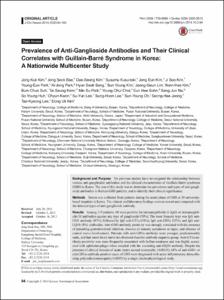Prevalence of Anti-Ganglioside Antibodies and Their Clinical Correlates with Guillain-Barré Syndrome in Korea: A Nationwide Multicenter Study
- Keimyung Author(s)
- Lim, Jeong Geun
- Department
- Dept. of Neurology (신경과학)
- Journal Title
- Journal of Clinical Neurology
- Issued Date
- 2014
- Volume
- 10
- Issue
- 2
- Abstract
- Background and Purpose:
No previous studies have investigated the relationship between various anti-ganglioside antibodies and the clinical characteristics of Guillain-Barré syndrome (GBS) in Korea. The aim of this study was to determine the prevalence and types of anti-ganglioside antibodies in Korean GBS patients, and to identify their clinical significance.
Methods:
Serum was collected from patients during the acute phase of GBS at 20 university-based hospitals in Korea. The clinical and laboratory findings were reviewed and compared with the detected types of anti-ganglioside antibody.
Results:
Among 119 patients, 60 were positive for immunoglobulin G (IgG) or immunoglobulin M antibodies against any type of ganglioside (50%). The most frequent type was IgG anti-GM1 antibody (47%), followed by IgG anti-GT1a (38%), IgG anti-GD1a (25%), and IgG anti-GQ1b (8%) antibodies. Anti-GM1-antibody positivity was strongly correlated with the presence of preceding gastrointestinal infection, absence of sensory symptoms or signs, and absence of cranial nerve involvement. Patients with anti-GD1a antibody were younger, predominantly male, and had more facial nerve involvement than the antibody-negative group. Anti-GT1a-antibody positivity was more frequently associated with bulbar weakness and was highly associated with ophthalmoplegia when coupled with the coexisting anti-GQ1b antibody. Despite the presence of clinical features of acute motor axonal neuropathy (AMAN), 68% of anti-GM1- or anti-GD1a-antibody-positive cases of GBS were diagnosed with acute inflammatory demyelinating polyradiculoneuropathy (AIDP) by a single electrophysiological study.
Conclusions:
Anti-ganglioside antibodies were frequently found in the serum of Korean GBS patients, and each antibody was correlated strongly with the various clinical manifestations. Nevertheless, without an anti-ganglioside antibody assay, in Korea AMAN is frequently misdiagnosed as AIDP by single electrophysiological studies.
- Keimyung Author(s)(Kor)
- 임정근
- Publisher
- School of Medicine
- Citation
- Bum Chun Suh et al. (2014). Prevalence of Anti-Ganglioside Antibodies and Their Clinical Correlates with Guillain-Barré Syndrome in Korea: A Nationwide Multicenter Study. Journal of Clinical Neurology, 10(2), 94–100. doi: 10.3988/jcn.2014.10.2.94
- Type
- Article
- ISSN
- 1738-6586
- Appears in Collections:
- 1. School of Medicine (의과대학) > Dept. of Neurology (신경과학)
- 파일 목록
-
-
Download
 oak-aaa-2771.pdf
기타 데이터 / 1.08 MB / Adobe PDF
oak-aaa-2771.pdf
기타 데이터 / 1.08 MB / Adobe PDF
-
Items in Repository are protected by copyright, with all rights reserved, unless otherwise indicated.